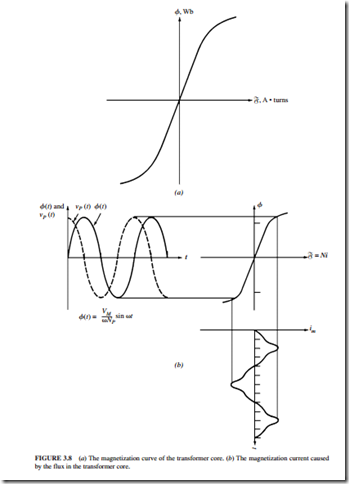THE MAGNETIZING CURRENT IN A REAL TRANSFORMER
When the ac power source is connected to a transformer, a current flows in the primary winding, even when the secondary winding is open-circuited. This is the current required to produce the flux in ferromagnetic core. It consists of these components:
1. The magnetization current im. The current required to produce the flux in the core of the transformer.
2. The core-loss current Ih e. The current required to make up for the hysteresis and eddy current losses.
Figure 3.8a illustrates the magnetization curve of a transformer core. The magnetization cur- rent can be determined if the flux in the core is known. If we assume that the leakage flux is negligible, the average flux in the core will be given by
Figure 3.8b illustrates the variations of the current required to produce the flux in the core. The following observations can be made:
1. The magnetization current is not sinusoidal. It has a higher-frequency component due to magnetic saturation in the transformer core.
2. In the saturation region, a large increase in magnetizing current is required to provide a slight increase in the flux.
3. The fundamental component of the magnetization current lags the applied voltage by 90°.
4. The higher-frequency (harmonic) component of the magnetization current increases as the core is driven into saturation.
The second component of the no-load current in the transformer is required to supply the core losses. The largest eddy current losses occur when the flux passes through 0 Wb because these losses are proportional to d /dt. The hysteresis losses are also the highest when the flux passes through zero. Therefore, the greatest core loss occurs when the flux goes through zero. Figure 3.9 illustrates the variations in the total current required to make up for core losses.
The total no-load current is known as the excitation current. It is given by
Figure 3.10 illustrates the total excitation current in a transformer.


